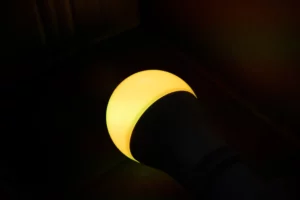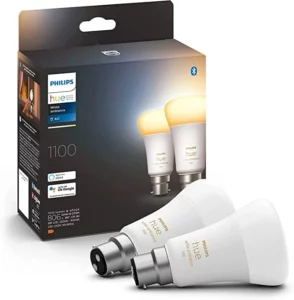If you’ve never entertained the thought of your smart devices spying on you, congratulations – you now have a new fear! On the other hand, if you have pondered this idea before, you might be having an ‘I knew it!’ moment, and what follows will be particularly intriguing.
When contemplating the notion of our smart devices surveilling us, we usually associate it with smart cameras and AI assistants like Alexa, Siri, or Bixby. They possess cameras and microphones that enable them to ‘listen’ to our conversations, making the concern understandable. However, what about lights? Their primary functions are turning on, turning off, and adjusting color and brightness.
It seems far-fetched to think they could be used for spying. But let’s delve into this concept and explore whether it’s even possible for your lights to spy on you. If there is a possibility, we’ll examine how this could occur and also how you can detect if your lights are, indeed, spying on you.
How Smart LED Light Strips/Bulbs Work?
Apart from some advanced smart lighting systems like Nanoleaf, most smart lighting setups are based on relatively straightforward technology – LEDs. They possess basic functionalities such as turning on, turning off, and changing colors.

If you’re fortunate, they might also have some fun flashing light features for parties or entertainment setups. When connected to a smart home hub or their respective apps, you gain additional options. For instance, you can program your smart lights to activate at specific times, use motion sensors, or even control them through voice commands.
The true value of smart lighting lies in its convenience, especially when you’re away from home for work or vacation. It aids in deterring thieves by simulating the presence of someone at home through automated on-off cycles. Moreover, it can light up your pathway, ensuring you don’t return to a dark house or walkway.
Smart lights utilize various wireless communication protocols, with the most popular being Wi-Fi, Zigbee, and Bluetooth. Through their respective apps (e.g., Hue, Alexa, Ring) and smart home hubs (if used), these lights wirelessly receive signals that dictate their actions.
However, despite their apparent simplicity, the question arises: Could these smart lights be doing more than just fulfilling their basic functions? Is there a possibility that they might be transmitting your personal information to external sources?
Are They Really Spying Us?
While smart lights may not engage in traditional spying, such as recording audio or video of our lives, they can gather data in other ways that serve marketing and product recommendations.
A familiar example is how search engines operate. When we search for something online, like “sofa sets,” the search engine’s algorithms track this information and use it to flood our social media timelines and email with ads related to sofa sets and furniture stores. This practice allows companies to target their advertisements more effectively to individuals who have shown interest in specific products or topics.
Similarly, when we connect our smart lights to a smart home hub like Alexa, they can collect data on how we use the lights. Over time, patterns may emerge in our lighting preferences, and the smart home hub may use this data to suggest routines or lighting configurations to optimize our experience.

Furthermore, the manufacturer of the smart lights might use the data they gather to send us emails with suggestions for other products based on our lighting usage patterns.
Fortunately, unless the smart lights are explicitly designed for surveillance purposes, they typically do not have built-in cameras or microphones that could be used for spying on us in the traditional sense. Nonetheless, it’s essential to be mindful of the data collected by smart devices and the potential implications for privacy and targeted advertising.
Can smart lights even be used for Spying?
Yes, it is technically possible to spy on conversations using LED light bulbs, but the cost and effort involved make it impractical for most cases. In an experiment, researchers demonstrated that it is possible to spy on household conversations by monitoring the vibrations of an LED light bulb. However, this method would only work if the conversations were held at very high decibel levels, which is not typical for everyday conversations.
Moreover, implementing such a spying technique would require expensive monitoring equipment, amounting to over $400, making it a costly and complex endeavor.
However, a more significant concern arises when considering the possibility of hidden cameras being concealed within light bulbs. This scenario is particularly alarming in public settings where security is of utmost importance, such as banks, government offices, airports, and train stations. These places have a high volume of activities and foot traffic throughout the day and night, making them potential targets for illegal surveillance.
To address these security concerns, authorities and organizations invest significant amounts of money in incorporating closed-circuit television (CCTV) cameras and audio-capturing technology in such areas. These measures help monitor activities and capture potential threats, ensuring the safety and security of the premises and the people within them.
Why are Wi-Fi/Bluetooth required for many smart lights?
Some smart home apps require multiple permissions, including Wi-Fi, Bluetooth, and GPS (location) access. There are several reasons for this:

- Remote Control: By connecting the smart devices to Wi-Fi and/or Bluetooth, users can control them remotely using their smartphones or tablets. This allows for convenient management of the smart devices from anywhere, even if the user is not at home. For example, you can turn on pathway lighting minutes before arriving at your driveway, ensuring a well-lit pathway upon your return.
- Initial Set-Up and Backup Communication: Some manufacturers may require a temporary Bluetooth or GPS connection during the initial setup process. This simplifies the setup and helps establish a connection between the app and the smart devices. Additionally, in the event that the Wi-Fi connection is temporarily unavailable, Bluetooth can serve as a backup communication method.
- Limited Range and Local Connection: Certain smart lights, like Philips Hue’s Bluetooth lights, use only Bluetooth for communication. While this limits the range to about 300 feet (or less in some cases), some users prefer this setup as it creates a more localized and potentially more secure connection. Others, however, favor Wi-Fi for its broader remote control capabilities.
It’s worth noting that the permissions requested by a smart home app are generally standard for their intended functionality. Most users find the benefits of remote control and ease of use outweigh any potential risks associated with granting these permissions. Additionally, the use of Wi-Fi and Bluetooth is prevalent in smart home technology to ensure seamless communication between devices and apps.
How can you know whether a smart light bulb has a covert camera?
. Nowadays, there are smart bulbs and smart lighting strips available in the market that come with integrated hidden cameras. However, it’s essential to note that legitimate products with hidden cameras typically indicate this feature on their packaging or product descriptions. If you are purchasing smart bulbs or lighting strips solely for lighting purposes, it is highly unlikely that they include hidden cameras.
If you have concerns and want to check if a smart bulb has a hidden camera, there are a few methods you can use:

- Infrared Lights: Most cameras, including hidden ones, use infrared lights to capture footage in low-light conditions. These lights usually emit a red or green tint. To check for this, turn off the light in a dark room and closely inspect the bulb to see if any lights are emitted from the center. If you observe lights within the bulb when it’s turned off, there might be an indication of a hidden camera.
- Reflective Surfaces (Camera Lens): Another way to identify a hidden camera is by looking for reflective surfaces within the bulb, which could be the camera lens. You can use your phone’s flashlight function to improve visibility. Turn off the light, hold your phone close to the bulb, and check if you notice any reflective surfaces inside. If you do, there’s a possibility of a camera lens being present.
- Buzzing Sound: Sometimes, electronic devices can cause slight humming or buzzing sounds when they interfere with each other’s radio frequencies. However, this is not a foolproof method. Smart lights often have their own radio frequency to communicate with the lighting system, which could lead to some buzzing. Therefore, if you hear a slight buzzing sound, it doesn’t automatically mean there’s a hidden camera present.
It’s essential to be vigilant and cautious when purchasing smart home devices, especially those with potential privacy implications. Always buy products from reputable manufacturers and vendors, and thoroughly read the product descriptions and reviews to ensure the features align with your requirements and expectations.
Wrapping it up
While the possibility of cameras inside smart LED bulbs is not entirely impossible, it is highly unlikely for several reasons. The technology required to incorporate cameras into these bulbs effectively can be very expensive, making it impractical and not cost-effective for the average smart home manufacturer.
In public places where security is crucial, such as airports, government offices, or banks, there may be instances where cameras are concealed within lighting fixtures to monitor activities and ensure safety. However, in residential settings, the likelihood of smart bulbs having hidden cameras is minimal.
For the average consumer purchasing smart bulbs for home lighting purposes, there is no need to worry about hidden cameras. Reputable manufacturers prioritize consumer privacy and security, and such practices would likely lead to severe legal consequences.
In conclusion, there is no need to be overly concerned about smart bulbs in our homes containing hidden cameras. The likelihood of this happening is extremely low, and consumers can trust that their privacy is safeguarded when using legitimate and trusted smart home products.
You May Also Enjoy Reading: What bulbs are compatible with Philips Hue?

